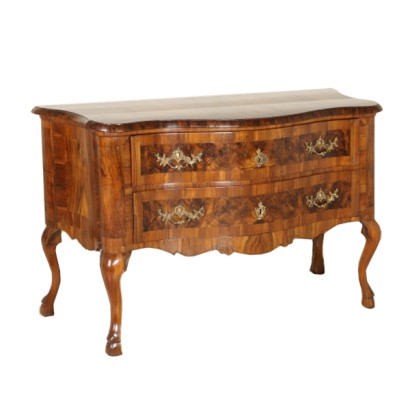Ferrara's 18th century Dresser
Features
Style: Barocchetto (1720-1770)
Age: 18th Century / 1701 - 1800
Origin: Ferrara, Italy
Main essence: Walnut
Material: Walnut Slab , Walnut Feather Banded , Walnut Burl
Description
Cassettone a due cassetti mosso sul fronte e sui fianchi.Sul fronte cartelle lastronate in radica di noce ferrarese con profili in noce rigatino. Montanti bombati posti a 45° (tipici della regione) terminano con gambe mosse e piedini a zoccolo caprino. Piano sagomato con modanatura in legno di testa e riserve in piuma di noce nei fianchi. Maniglieria in bronzo ed interni in pioppo.
Product Condition:
Requires small restoration and resumption of polishing.
Dimensions (cm):
Height: 86,5
Width: 140
Depth: 63
Certificate issued by: Dott. Cuoccio Vittorio
Additional Information
Style: Barocchetto (1720-1770)
With this term we designate, for what specifically relates to furniture, a part of the production carried out in Italy in the period of time between the Rococo era and the first phase of neoclassicism.It is characterized by the formal and decorative structure still rigidly adhering to the dictates dear to the Baroque period (hence the term baroque) and to the Louis XIV fashions and yet the new times are captured in the adoption of smaller volumes, more decorative modules. elegant, often directly inspired by French fashion, but always executed with rigorous principles of ornamental symmetry.
The tendency to assimilate formal and volumetric novelties but not to incorporate their ornamental elaboration finds natural explanation in Italy in the fact that in this century the great aristocracy experienced an unstoppable political and economic decline.
If in the previous century there was a great profusion of furnishings destined to adorn newly built homes, to proudly show the power of the client family, in the eighteenth century they rather take care to update the building with only the furniture strictly necessary for the new needs imposed by fashion or functional needs.
The old scenographic apparatus is maintained and the new must not contrast too much.
Find out more about the Barocchetto with our insights:
Classic Monday: discovering Barocchetto
Classic Monday: between Baroque and Barocchetto
Classic Monday elegant and unusual with two Barocchetto balustrades
FineArt: Pair of Barocchetto chairs, Venice
Emilian canterano first quarter XVIII century, first Barocchetto
Ribalta a urn, Milan mid-18th





























